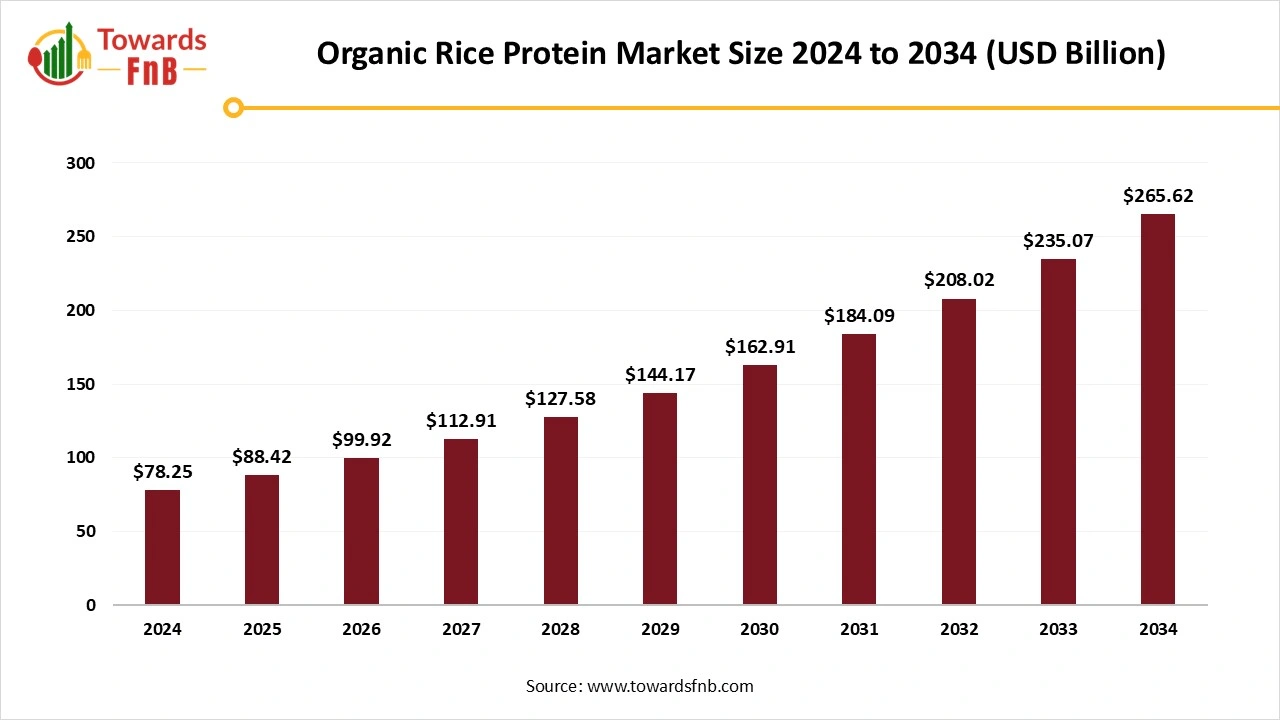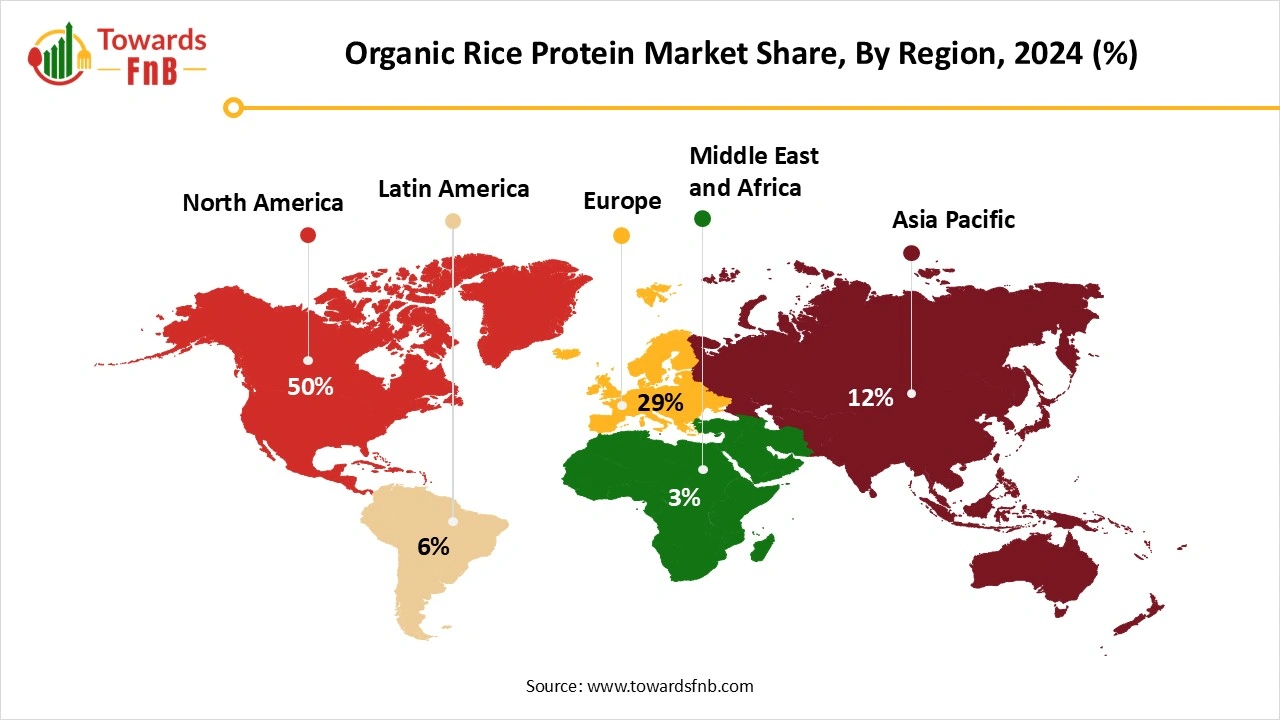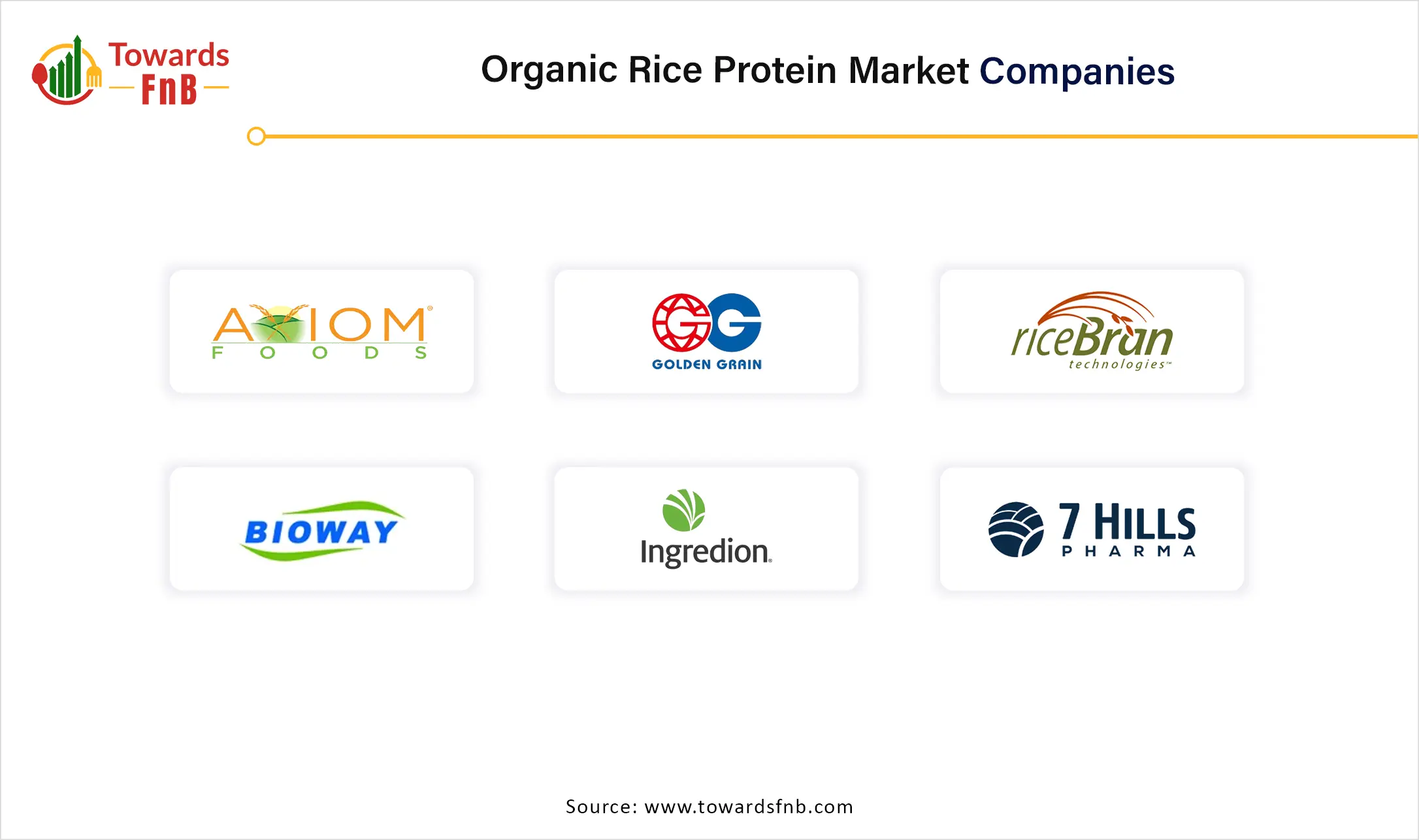December 2025
The global organic rice protein market size was estimated at USD 78.25 billion in 2024 and is expected to rise from USD 88.42 billion in 2025 to nearly reaching USD 265.62 billion by 2034, growing at a CAGR of 13% during the forecast period from 2025 to 2034. With the fruitful economic and health benefits of rice production, the value of traditional protein products is also increasing in the global market.

| Study Coverage | Details |
| Growth Rate from 2025 to 2034 | CAGR of 13% |
| Market Size in 2025 | USD 88.42 Billion |
| Market Size in 2026 | USD 99.92 Billion |
| Market Size by 2034 | USD 265.62 Billion |
| Largest Market | North America |
| Base Year | 2024 |
| Forecast Period | 2025 to 2034 |
| Regions Covered | North America, Europe, Asia-Pacific, Latin America, and Middle East & Africa |
With the organic rice protein products, the agricultural area is covered by various crops like foodgrains, millets, cereals, wheat, oilseeds, sugarcane, etc. The governments are focusing on enhancing the growth of farmers by identifying primary growth sources. The principal growth drivers of the organic rice protein market include increase in crop productivity, increase in livestock productivity, resource use efficiency, increase in cropping intensity, etc.
Furthermore, the other rationales behind the market’s success include diversification to high-value agriculture, remunerative prices on farmers’ produce, and the shift of workforce from farm to non-farm businesses. The various government schemes are introduced for the welfare of farmers to increase their agricultural production, remunerative returns, and provide income support to farmers.
Organic Plant-based Protein Products of Bioway Organic Group Limited, a Versatile Botanical Extract Company
| Sr. No. | Name of the Product | Key Components | Biological Functions | Applications |
| 1 |
Rosa Roxburghii Fruit Extract |
|
|
|
| 2 |
Soy Protein Isolate ISP610K |
|
|
|
| 3 |
Organic Pea Protein |
|
|
|
(Source: BIOWAY)
The U.S. Department of Agriculture (USDA) introduced new procedures to improve accountability for organic food and beverage products. It has enabled every part of the supply chain to become certified and verified. Axiom is one of the small-scale, verified, and organic-certified suppliers of rice protein and the only FDA GRAS. There is a significant increase in the quantity of reliable organic-certified products formulated with rice protein.
This surge is observed due to the challenges in sourcing reliable organic pea protein due to a lack of organic pea crops. There is a greater popularity of rice protein than other protein sources due to the clinically proven and high-quality protein content of rice. Rice protein is 100% digestible, which makes it suitable to fulfill the various dietary needs related to dairy-free, vegan, celiac, and sports nutrition.
The potential challenges arise with the growing consumer demand for cultivated rice without the use of chemicals. It is needed to access international and local organic rice markets. The organic certification standards must align with international standards. It is also challenging to plan and implement the planned certification initiatives.
How North America Dominated the Organic Rice Protein Market in 2024?
North America dominated the organic rice protein market in 2024. The U.S. Department of Agriculture (USDA) introduced the ‘Organic Market Development Grant Program’ for transportation and marketing. This grant was intended to improve and expand market access to small and underserved organic farmers. This grant program aims to identify the key barriers in organic sales, create opportunistic ways for organic producers, and educate farmers with communication tools to talk with buyers about organic things.
In Northern California, the Rock Front Ranch’s (RFR) project aims to expand organic marketing by improving the efficiency of transportation of organic products for potential consumers. It also focuses on providing improved market access for whole foods and other organic stores in the Northern California region.

How do the Strong Commitments of the Organic Trade Association (OTA) and Organic Farming Companies Drive Advancements in the U.S. and California?
The Organic Trade Association (OTA) is situated in Washington, D.C. and is responsible for increased federal investments, policies that drive farmers' success, and the identification of organic factors. The OTA makes efforts to provide organic food for schools and families by improving access to organic food and developing the organic market. It also focuses on expanding the opportunities of farmers to cultivate health for the global population. It believes in organic solutions that are scalable to the economic, societal, and environmental challenges of the world.
California Certified Organic Farmers (CCOF), Inc. is the largest organic agriculture organization in California and owns the largest organic certification company in the United States. This company has strong working experience of over 50 years with organic producers. It focuses on product marketing to expand economic opportunities for small and underserved farmers.
Major 2025 Agricultural Announcements by the U.S. Environmental Protection Agency (EPA): (Source: EPA)
Asia Pacific is Expected to Grow at the Fastest CAGR in the Organic Rice Protein Market During the Forecast Period.
The National Programme for Organic Production (NPOP) was introduced and implemented by the Ministry of Commerce & Industries, Government of India. This program encompasses the standards of organic production, accreditation of certification bodies, promotion of organic farming and marketing, etc. The Asia Pacific and the Chinese governments in this region are investing in advanced technologies and alternative proteins. The cultivated meat research and the 5-year governmental plan fuel the innovations in alternative proteins and other modern technologies. The Japanese government believes in the importance of technologies like ‘food tech’, including cellular foods, for a sustainable food supply.
How does India Lead the Agricultural Sector by Being the Second-Largest Producer of Rice in the World
India holds a strong position in the agricultural production of wheat, cereals, fresh fruits, vegetables, processed food, animal products, etc. Furthermore, India largely produces other food products, including organic products, millets, cashews, groundnuts, alcoholic beverages, floriculture, and seeds. There is a huge demand for cereals in the global market, which creates excellent opportunities for the export of Indian cereal products. The major export areas for India were Iran, Saudi Arabia, the United Arab Emirates (UAE), Vietnam, and Benin for the year 2023-24. Organic products are exported to the European Union, the USA, Canada, Sri Lanka, Great Britain, Vietnam, Australia, Thailand, Switzerland, New Zealand, the Korean Republic, Japan, etc.
2024 Organic Production in India by the Government of India:
Europe is Seen to Grow at a Notable Rate in the Organic Rice Protein Market in 2024.
The European Union focuses on research and economic development programs to offer a wide range of solutions to different arising issues. The EU policymakers introduced public funding to accelerate the R&D of alternative proteins. This funding assistance also boosts the commercialization of products while achieving environmental sustainability. The European Union is the large supporter of alternative proteins at the level of all production stages, product types, and issue areas.
The EU is also a leading supporter of fermentation technology, by means of which the European Commission approved the novel food application of MycoTechnology for FermentIQ, which is a pea and rice protein product. The Protein Brewery, Nature’s Fynd, Perfect Day, and Solar Foods also submitted novel food applications to the European Union. Additionally, the EU was involved in the assessment of soy leghemoglobin by Impossible Foods as both a genetically modified food and a food additive.
What Makes France the Leading Supporter of the European Agricultural and Protein Sector?
France leads the plant-based protein sector by supporting business grants, investments, and funding for several research initiatives. It supports research into new proteins from plants, algae, and microbes to scale up plant protein processing and commercialization. The French pulse crop producers get several benefits from multi-million-euro research projects and plant-based alternative proteins.
How Rice Protein Isolate Segment Dominated the Organic Rice Protein Market in 2024?
The rice protein isolate segment dominated the organic rice protein market in 2024. The rice protein isolates are popular due to their 100% vegetarian and plant-based forms that are made from natural varieties of rice. They are advantageous due to low levels of fat and carbohydrates and are free from sugars and aspartame. There is no use of artificial colors, and they are good sources of diet, being natural plant proteins.
The Rice Protein Concentrate Segment is Expected to Grow at the Fastest CAGR in the Organic Rice Protein Market During the Predicted Timeframe.
There is a growing demand for rice protein concentrate as a promising solution to fulfill the emerging need for plant-based protein sources. These plant-based protein sources are highly preferred as alternatives to traditional animal-based proteins. They offer a wide availability and a favorable nutritional profile enriched with essential amino acids.
What Made Sports and Energy Nutrition the Dominant Segment in the Organic Rice Protein Market in 2024?
The energy and sports nutrition segment dominated the organic rice protein market in 2024. Sports and energy nutrition raises the need for protein consumption, which is important for muscle repair, growth, and recovery after heavy workouts. There is a vital role for nutrients like vitamins, minerals, and antioxidants in maintaining a strong immune system and reducing the risk of illnesses. It improves performance, elicits a quick immune response, and reduces risks of injuries.
The Meat Analogues and Extenders Segment is Expected to Grow at the Fastest CAGR in the Organic Rice Protein Market During the Forecast Period.
A variety of forms of meat analogues include coarse-ground meat analogues such as burgers, sausages, meat balls, pizza toppings, etc. and emulsified meat analogues such as deli meats, frankfurters, and spreads. Some of the major non-meat protein sources that are suitable for meat analogues are soybean, legumes, oil seeds, wheat, rye, and barley. A variety of types of proteins from these non-meat protein sources are glycinin, globulins, albumins, legumin, etc.
Axiom Foods, Inc.
Bioway Organic Group Limited

By Product
By Application
By Region
December 2025
December 2025
November 2025
November 2025